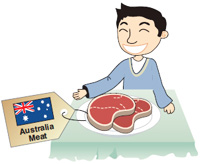More than luck helps Australia beat US in beef war
 Why is Australian beef popular in Korea? It is more than its image of being clean and healthy with its cattle ranging free on vast farms, thereby avoiding exposure to feed that could cause bovine spongiform encephalopathy (BSE), or mad cow disease.
Why is Australian beef popular in Korea? It is more than its image of being clean and healthy with its cattle ranging free on vast farms, thereby avoiding exposure to feed that could cause bovine spongiform encephalopathy (BSE), or mad cow disease.
It requires history to explain because Australian beef got its foothold thanks to an import ban on American beef in 2003 when a cow in Washington State tested positive for BSE.
Its market share back then was a mere 15 percent, compared with 70 percent for American beef.
Aussie beef became top-selling imported beef from 2003 with a market share of 60 percent in 2010.
A industry source familiar with Australian beef said there have been ups and downs in terms of market share against American beef.
“It sold very well until the Korea-U.S. free trade agreement was ratified last year and after this, the market share of Aussie beef kind of stalled. It rebounded again after the recent California mad cow disease case,” the source said said.
But the question is why beef from other countries such as New Zealand has failed to repeat the Australian success.
A government official said no data was available to gauge if the mad cow disease had any effect on the market share of minor players such as Canadian or New Zealand.
Industry experts said consumers’ limited access is one reason why their market share is low.
John Hundleby, market manager of the Seoul branch of Beef and Lamb New Zealand, pointed his finger at the relatively small volume of beef import as a reason.
“The main reason probably is our export volume is much smaller than Australia. We supply beef between 30,000 to 40,000 tons each year for Korean consumers, but Australia exports much more than us,” he said. “Australian beef is much more readily available for Korean consumers.”
Some people familiar with Kiwi beef claimed that ineffective marketing may explain why its market share is much lower than Aussie beef.
They said Australian beef, not New Zealand beef, came first to mind to Koreans when talking about, pure and healthy beef, because of successful marketing.
Kiwi beef might have had higher consumption in Korea if ranchers or marketing people had launched a “clean and pure” campaign earlier than Aussie cattle ranchers did.
Korea is an important market for international ranchers. It was the third largest market for American beef before the outbreak of mad cow disease; and the fourth largest market for Canadian beef in 2003 before an import ban after a cow was confirmed to have been infected with the disease. Canadian annual beef exports here were valued at $50 million a year before the import ban.
Korea resumed importing Canadian beef cuts from cows younger than 30 months old from this January. <Korea Times/Kang Hyun-kyung>





















































